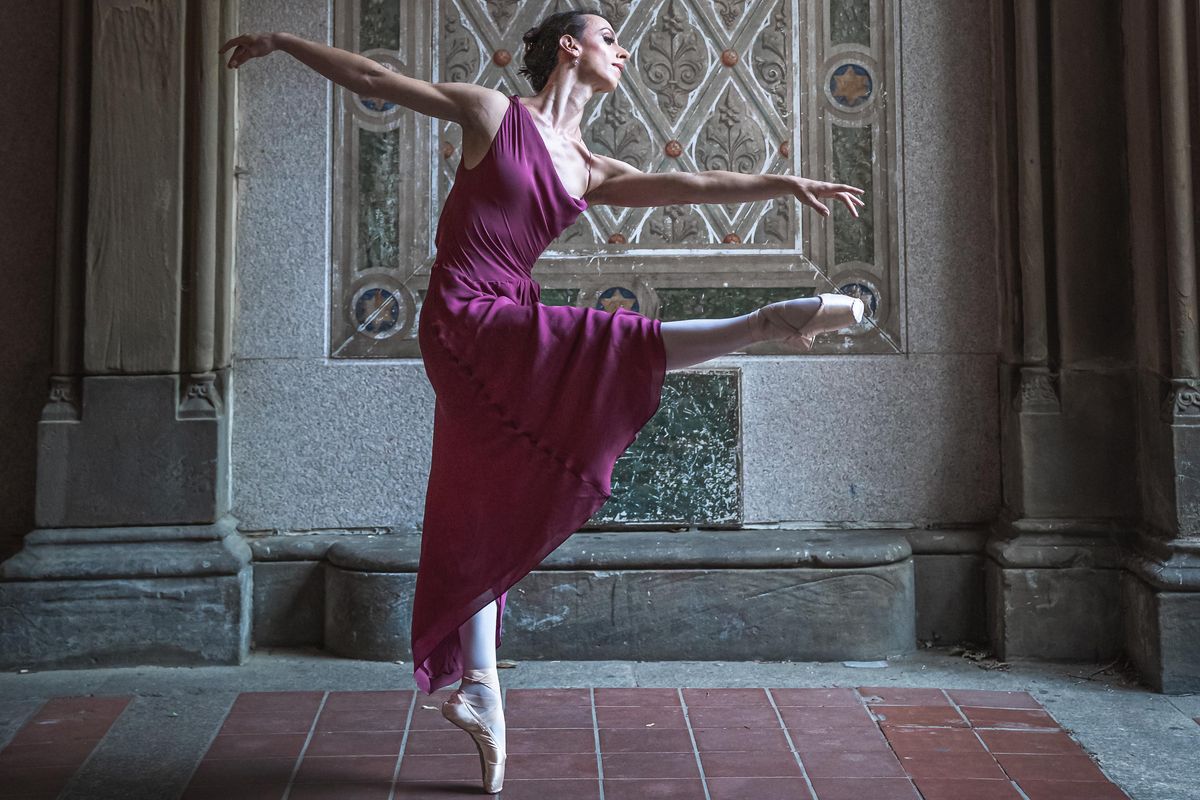Inside Former Trocks Dancer Sabrina Pretto’s Year of Transitions
Taking center stage in Sleeping Beauty‘s “Canary Variation,” Sabrina Pretto dazzled in her pale yellow leotard and skirt, her footwork quick, arms expressive, and face broken into a wide, genuine smile. Dancing with Sheep Meadow Dance Theatre, a New York City–based troupe helmed by choreographer Billy Blanken, this was Pretto’s first time back onstage since retiring from Les Ballets Trockadero de Monte Carlo in October 2019. It was also Pretto’s first time performing as a trans woman—as Sabrina, and not Alberto, the name she was given at birth.
Pretto, 35, grew up in Vicenza, Italy, and came to ballet at the relatively late age of 14. She trained at the Princess Grace Academy in Monte Carlo before joining the German company Stadttheater Koblenz. It was during her two years there that Pretto began to feel a sense of discomfort with what was being asked of her as a dancer.
“The roles were very set in stone, and I had to do a lot of partnering and a lot of male parts,” she remembers. “I felt weird and not in my place.”
In response to feeling “boxed in,” Pretto turned to one of her earliest passions: pointework. Though she’d been taking some classes on pointe since her days as a young student in Italy, she now started wearing pointe shoes regularly, and rehearsing female variations on her own. One day, while expressing her frustrations to the company’s director, he recommended that Pretto look into the Trocks. And after a few rounds of auditions, Pretto packed her bags and moved to New York.
Pretto’s eight years with the Trocks were rich with opportunity and experience, and she says her talents were nurtured. But as time went on, Pretto began to feel like there were still parts of her gender expression that she was forced to tamp down.
“When I had to represent the company, I might be asked to wear something less feminine or appear in a different way,” she says, referring to open rehearsals or travel days on tour.
In 2018, former Trocks dancer Chase Johnsey came forward with claims of harassment and discrimination by the company management, alleging that he was told he could no longer perform with the company should he choose to undergo a gender transition, a message Pretto says that she had also always understood. “It was never said in black and white, but I knew that it would have caused problems,” she says. (An independent investigation following Johnsey’s claims found no merit to the legal allegations.)

Pretto waited until she felt she’d gotten the most out of her time with the Trocks before leaving. “I do feel that it would be amazing if they understood that there is a bigger spectrum of gender identities,” says Pretto. “Things are changing, and if they don’t keep up with the times they’ll be left behind.”
Pretto thinks of the past two years as her transition in every sense. At the same time as she made her career change, she also began hormone therapy. Though she tried to continue her daily regimen of ballet class, she found that the effects of the hormones made dancing at a high level nearly impossible during the first few months. “I felt very out of breath, and was having palpitations when I was doing small jumps,” says Pretto. Though she worked with her doctors to readjust her dosages, she felt that her stamina was lacking. And then, just as she was adjusting to dancing in her changing body, COVID-19 hit.
The pandemic forced her to take a break, and the time off gave her the space to open up her eyes to what else she might be interested in pursuing. She applied for a slew of jobs, eventually landing positions teaching ballet at New York City’s American Youth Dance Theater and as a makeup consultant at Ulta Beauty. She also runs a small-scale sewing business, making dancewear and costumes for friends and select customers.
And now, thanks to SMDT, Pretto has been able to incorporate performing into her life once again. At first, rehearsing for Sleeping Beauty felt hard both physically and emotionally. “It was a struggle of knowing your body used to be able to do things that it can’t do anymore, but I sort of accepted it because there’s no use fighting and getting upset over that,” says Pretto. She also faced anxieties about comparing herself to cisgender ballerinas, feelings that dissolved once she was warmly welcomed by the rest of the cast. “I didn’t even realize honestly that I used to perform with drag makeup and wigs, and in comparison this felt very natural, it felt organic,” says Pretto.
Pretto’s decision to wait so long to transition was born of fear that she’d have to give up her dance career. She holds close the hope that the ballet world will continue to become more accessible to dancers of all stripes so others might not have to wait in the same way that she did.
“I was always so afraid of not being able to fit into the mold of ‘ballerina,'” she says. “But the human body’s beautiful. All different types of people can dance amazingly.”
Update July 29, 2021: This story has been updated to reflect that an investigation of Johnsey’s 2018 claims found no merit to his legal allegations.





